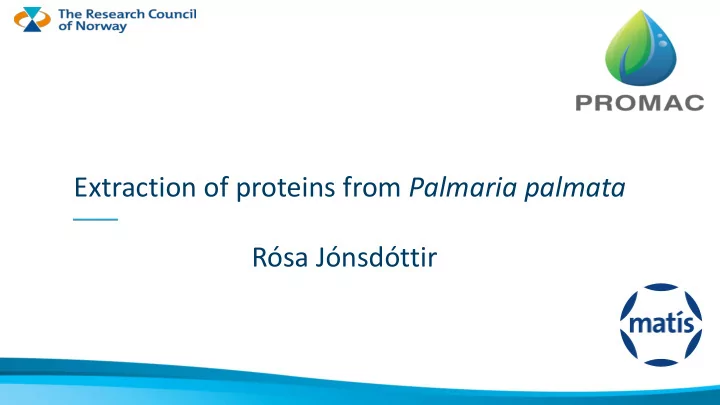

Extraction of proteins from Palmaria palmata Rósa Jónsdóttir
Background • Increasing demand for high quality protein both for food and feed • The access to high quality protein is becoming more challenging • Important to find alternative food sources including protein alternatives that contain all the essential amino acids fulfilling human requirements 2
Utilisation of Palmaria palmata • Palmaria palmata - dulse • Good nutritional value • Suitable for human food and animal feed application • Utilized as food in Iceland for centuries 3
Background ✓ High protein content (up to 35%) – Comparable to high protein vegetables e.g. soybeans ✓ Main polysaccharide is xylan (34-35%) ✓ P. palmata has a rigid cell wall consisting mainly of β - (1→4)/β - (1→3) -D-xylans along with some fractions of cellulose and β - (1→4) -xylans ✓ Due to the strength of the cell wall, traditional protein extraction methods might give limited results
Objectives ✓ Develop fractionation processes for preparation of protein-rich products and extracts to be used as food, nutraceutical or feed ingredients ✓ Explore the use of enzymes (xylanse and protease) as processing tool ✓ Study protein yield, quality and the bioactivity of the different fractions
Material and methods • P. palmata from Norway (NIBIO) • Preprocessing: wet-milling • Enzyme hydrolyzation • Filtration • Chemical analysis (water, fat, salt, ash, protein) • Protein – SDS-PAGE; Nitrogen; – Amino acids (SINTEF) • Bioactivity (TPC, ORAC, DPPH, MC, ACE)
Enzymes Optimum conditions and activity Optimum conditions Producer Enzyme Activity Temperature pH Endo- and exo-peptidase Umamizyme Amano enzymes Inc. 7.0 50 complex Endo- and exo-peptidase ProteAX Amano enzymes Inc. 6.0 60 complex Endo-1,4- β -xylanase Xylanase Matis ltd 6.5 60 Xylanase is derived from a bacterium belonging to the genus Planifilum, of the family Thermoactinomycetaceae according to 16S rRNA sequence analysis and blasting to the NCBI nr database (Matís, unpublished results).
Flow chart of the extraction process 100 µm sieve Freeze drying Freeze drying
Extraction yields of dry matter of both fractions liquid extract and solid phase Yield 70 60 Extraction yield (%dw) 50 40 Liquid extract 30 Solid phase 20 10 0 Control Umamizyme Xylanase Xylanase and Umamizyme Umamizyme
Amino acid composition and protein content of P. palmata Essential amino acids, % of total amino acid content Values for untreated seaweed (n=1) are presented as % of total amino acid content. Values for control, xylanase, xylanase + Umamizyme and Umamizyme (n=2) are presented as % of total amino acid content. Values for nitrogen content are presented as % dry weight ± SD (n=4). 10
Amino acid composition and protein content of P. palmata Essential amino acids (EAA) • All EAA were present in the samples • EAA ratio higher in all solid phase samples compared to liquid extract • EAA ration higher in liquid extract when treated with protease ― Protease break down proteins into peptides and amino acids passing the 100 µm sieve after the hydrolysis => resulting in higher amino acid content in liquid extract. 11
Protein content of P. palma ta, untreated and enzymatically treated, using different N conversion factor 60 N = 6.25 54.9 55 50 Calculated conversion factor 45 Protein content (% dw) 40 33.4 35 30 25 20 15 10 5 0 Untreated Liquid Solid Liquid Solid Liquid Solid Liquid Solid extract phase extract phase extract phase extract phase Values are presented as Control Xylanase Xylanase + Umamizyme % dry weight ± SD (n=4). Umamizyme Conversion factor 4.7 3.6 4.1 2.5 3.8 2.9 3.5 3.2 3.4
Bioactivity of different fractions of P. palmata antioxidant activity 100 9.0 Liquid extract 90 8.0 80 Solid phase 7.0 Metal chelating ability (%) 70 6.0 DPPH, IC 50 values 60 5.0 50 Liquid extact 4.0 40 Solid phase 3.0 30 2.0 20 1.0 10 0.0 0 Control ProteAX ProteAX and Umamizyme Xylanase Xylanase and Umamizyme Umamizyme Umamizyme Control ProteAX ProteAX + Umamizyme Xylanase Xylanse + Umamizyme Umamizyme 75 Umamizyme 200 75 200 Metal chelating ability (%) DPPH antioxidant activity, IC 50 values High antioxidant activity in some High antioxidant activity in liquid extracts solid phase and liquid extract 13
ACE (angiotensin converting enzyme) inhibition activity of different fractions of P. palmata IC 50 (mg/mL) Liquid extract Solid phase Control >1.00 >1.00 ProteAX 0.45 ± 0.11 >1.00 Blood pressure ProteAX + Umamizyme 75 0.38 ± 0.02 >1.00 Umamizyme 75 0.69 ± 0.05 >1.00 Xylanase >1.00 >1.00 Xylanase + Umamizyme 200 1.14 ± 0.08 >1.00 Umamizyme 200 >1.00 >1.00 14
Conclusion • P. palmata contains high protein content of good quality that can be extracted with good results using enzymatic treatment with xylanse • Xylanase disrupted the rigid cell wall, resulting in higher protein yield in the solid phase • Protein extract from P. palmata is high in essential amino acids and would therefore be suitable as food and nutraceutical ingredient • The results indicate that hydrolysis with protease can be a beneficial method to extract bioactive hydrolysates from P. palmata 15
Publications
Acknowledgement Málfríður Bjarnadóttir, Matís Björn Viðar Aðalbjörnsson, Matís Anna Nilsson, Matís Guðmundur Óli Hreggviðsson, Matís Ólafur H. Friðjónsson, Matís Rasa Slizyte, SINTEF Ocean Michael Y. Roleda, NIBIO 17
rosa.jonsdottir@matis.is
Recommend
More recommend